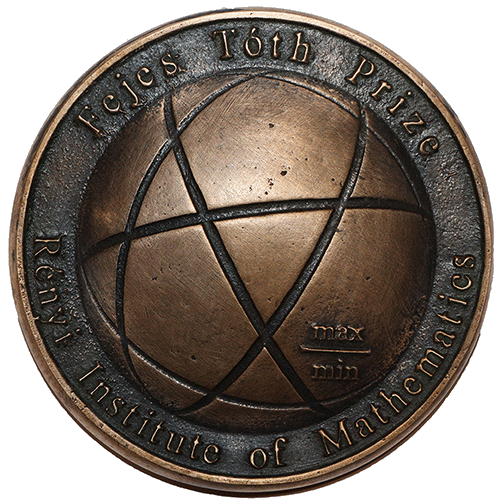
Maryna Viazovska, a Ukrainian mathematician who became world-famous for solving the 8- and 24-dimensional sphere packing problem, received the László Tóth Fejes Medal yesterday. The Rényi Mathematical Research Institute intends to recognize with this award an internationally significant mathematical work in the field of geometry (broadly understood). The award and the accompanying medal were established in 2023, paying tribute to the world-class geometer, László Fejes Tóth, who was the second director of the Rényi Institute from 1970 to 1983.
In her presentation before the award ceremony, Maryna Viazovska presented a recent result, jointly achieved with Emmanuel Abbe, Colin Sandon, and Vladyslav Shashkov, where they provided a new proof of an information theory result using additive combinatorial tools. Namely, in the case of a communication channel, Shannon had already proven that the maximum possible coding rate can be achieved with appropriate random coding. Reed-Muller error-correcting codes, created in the 1950s, are deterministic codes that also have this optimality, but this was only proven in 2023 by Abbe and Sandon. In her presentation, Maryna Viazovska outlined a proof of this result (or a slightly weaker version of it) based on the additive combinatorial Freiman-Ruzsa theory.
Maryna Viazovska is currently a professor at the Institute of Mathematics and head of the Department of Number Theory at the École Polytechnique Fédérale de Lausanne. Among her many other awards, she received the Fields Medal in 2022 for proving that the E8 lattice provides the densest arrangement of identical spheres in 8 dimensions, and for her further contributions to related extremal problems and interpolation problems in Fourier analysis. Maryna Viazovska is the second woman to receive a Fields Medal.
The Ukrainian mathematician was born in 1984 in Kiev. He received his bachelor's degree from Kiev National University in 2005 and his master's degree from the University of Kaiserslautern in 2007. From 2008 to 2012, he was a doctoral student of Don Zagier, working on modular forms. He received his doctorate from the University of Bonn in 2013. After a postdoctoral position at Humboldt University in Berlin, she joined the Faculty of Basic Sciences at the École Polytechnique Fédérale Lausanne, where she has been a professor since 2018.


